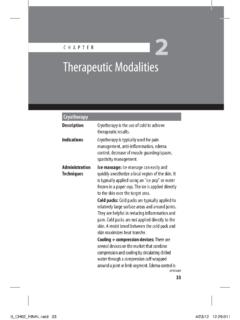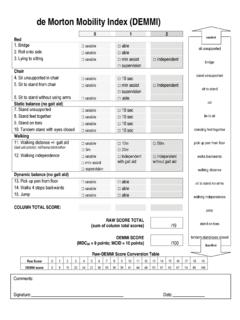Transcription of FACT Using Evidence to Select an Ankle SHEET With …
1 FACT Using Evidence to Select an Ankle Foot Orthosis (AFO) for Children SHEET With Cerebral Palsy What Types of AFOs Are Appropriate to Consider for Children With Cerebral Palsy?1. Standard (Solid Ankle ) (SAFO): No motion at Ankle (pictured right). Hinged (Articulated) AFO (HAFO): Free dorsiflexion, 0 plantarflexion (pictured left). Posterior Leaf Spring (PLS): Limited, resisted, plantar flexion and dorsiflexion, with only a few degrees of motion, posterior trim line behind malleolus, giving it a thin posterior heel support that widens into a calf band (pictured right). Ground (Floor) Reaction AFO: Rear-entry device with anterior shin and foot sections Section on Pediatrics, APTA (pictured left). 1111 North Fairfax Street Alexandria, Va 22314-1488. Not pictured: Phone 800/999-2782, ext. 3254 Dynamic AFO (DAFO): Free dorsiflexion and Fax 703/706-8575.
2 Plantarflexion and wraparound foot and Ankle Tone Reducing AFO (TRAFO): Ankle dorsi- flexion limited by hinge block with raised toe plate, molded arch, and transverse metatarsal arch Dual Carbon Fiber Spring (CFO): Carbon fiber at dorsal part of orthosis, 0 plantarflexion How Do I Incorporate Research Evidence children and adolescents with cerebral palsy9. Into My Clinical Decision Making? If the use of an orthosis improves walking, it does This information needs to be combined with clini- not necessarily improve stair climbing, running, or cal expertise and individual/client values to achieve jumping6. Evidence -based practice. Application of this process includes the use of the Evidence to make decisions on interventions to meet the identified individual/ How to Begin? client outcome. Peer-reviewed journal results reflect Begin with a specific diagnosis: CP, spastic quad, group means with individual variation.
3 Therefore, spastic diplegia, hemiplegia, Down syndrome, individual/client data (systematically collected) spina bifida must be monitored to see if the outcome is being achieved or if the intervention needs to be changed. Identify an age range What Are Some of the Conclusions Describe the child's level of function before and Regarding Utilization of AFOs? after intervention AFOs may provide better functional outcomes Have a clear description of the type of AFO being than standing or walking barefoot for children considered with CP, but the type of AFO does not always make a significant difference in the outcome2,3 Look for recent systematic review articles and randomized control trial articles Research supports the concept that the benefit of orthotics is limited to the direct mechanical Consider what level of significance is needed. effect on the joint it covers4 Statistically significant is a result of numeric cal- culation.
4 If observation of individuals suggests a Functional benefit of AFOs is likely due to the difference, then the results are clinically different. external support and stability provided by the Walking during day-to-day activity makes the data brace and to limiting the available range of mo- ecologically relevant tion5. Do not generalize results beyond the specifics of AFOs that limit plantarflexion have a positive the article effect on equinus gait but their effects on other functions are not known6,7. How Do I Know Which Type of AFO to DAFO, SAFO, PLS, HAFO, and Ground Reac- Recommend? tion AFOs all failed to improve static foot align- ment in the majority of children with CP who Given the limitations of AFOs identified in peer- could walk5 reviewed research: Young children who are independent walkers Consider a Standard (Solid) AFO When: benefit greater from AFOs than children Using External support, stability, and limit on Ankle assistive devices8 range of motion are needed5.
5 Tone-reducing design did not seem to improve Ankle motions are excessive and a more stable any functional outcome measurements6,7 Ankle is needed5. Wearing orthotics, compared to no orthotics, Increased stride length and decreased cadence are did not improve ambulation and balance when desired3. measured in a simulated functional context for 2 Fact SHEET : Using Evidence to Select an Ankle Foot Orthosis (AFO) for Children With Cerebral Palsy Specific skill execution is limited when barefoot10 REFERENCES: Walking results in excessive energy expenditure11 1. Dabelstein J. Lower-leg orthoses and casts. In: Wadsworth C, Laubenthat K, eds. Home Study Consider a Hinged (Articulated) AFO When: Course LaCrosse, WI: Orthopaedic Sec- Dorsiflexion at initial contact is limited or absent12 tion, APTA; 2000. 2. Buckon CE, Thomas SS, Jakobson-Huston S, Shoes provide limited plantarflexion power12 Sussman M, Aiona M.
6 Comparison of three Ankle -foot orthosis configurations for children A dynamic equinus deformity is present in chil- with spastic hemiplegia. Dev Med Child Neurol. dren with hemiplegia13 2001;43(6):371-378. 3. Radtka SA, Skinner SR, Dixon DM, Johan- Sit-to-stand takes too long14 son ME. A comparison of gait with solid, dynamic, and no Ankle -foot orthoses in chil- Walking speed and stride length are too short in dren with spastic cerebral palsy. Phys Ther. children with hemiplegia13,15 1997;77(4):395-409. 4. Crenshaw S, Herzog R, Castagno P, et al. The A heel-toe pattern is lacking15 efficacy of tone-reducing features in orthotics on the gait of children with spastic diplegic ce- There is excessive knee hyperextension in children rebral palsy. J Pediatr Orthop. 2000;20(2):210- with hemiplegia2 216. 5. Westberry DE, Davids JR, Shaver JC, Tan- More dorsiflexion is needed on stairs16 ner SL, Blackhurst DW, Davis RB.
7 Impact of Ankle -foot orthoses on static foot alignment in Consider a Dynamic AFO When: children with cerebral palsy. J Bone Joint Surg. Increased stride length, decreased cadence, and 2007;89(4):806-813. decreased Ankle motion are desired3 6. Autti-Ra mo I, Suoranta J, Anttila H, Malm- ivaara A, Ma kela M. Effectiveness of upper Motor skills (crawling/kneeling, standing, and and lower limb casting and orthoses in children walking/jumping) as measured on the Gross Motor with cerebrapalsy: an overview of review arti- Function Measure (GMFM) are delayed or absent8 cles. Am J Phys Med Rehabil. 2006;85:89 103. 7. Effgen SK, McEwen IR. Review of Selected Consider a Posterior Leaf Spring Brace When: Physical Therapy Interventions for School Age Knee extension needs to be increased2 Children With Disabilities. Center on Personnel Studies in Special Education.
8 COPSSE Docu- Consider Dual Carbon Fiber Spring (CFO) When: ment No. OP-4; 2007. Power during push-off is limited17 8. Bjornson KF, Schnmale GA, Adamczyk-Foster A, McLaughlin J. The effect of dynamic Ankle foot orthoses on function in children with cere- bral palsy. J Pediatr Orthop. 2006;26(6):773- 776. 9. Knott KM, Held SL. Effects of orthoses on upright functional skills of children and adoles- cents with cerebral palsy. Pediatr Phys Ther. 2002;14:199-207. 10. Buckon CE, Thomas SS, Jakobson-Huston S, Moor M, Sussman M, Aiona M. Comparison of three Ankle -foot orthosis configurations for children with spastic diplegia. Dev Med Child Neurol. 2004;46(9):590-598. Section on Pediatrics, American Physical Therapy Association 3. 11. Mossberg KA, Linton KA, Friske K. Ankle -foot orthoses. Gait Posture. 2006;24(4):467-474. orthoses: effect on energy expenditure of gait in 16.
9 Thomas SS, Buckon CE, Jakobson-Huston S, spastic diplegic children. Arch Phys Med Rehabil. Sussman MD, Aiona MD. Stair locomotion in 1990;71(7):490-494. children with spastic hemiplegia: the impact of 12. Rethlefsen, S, Kay R, Dennis S, Forstein M, Tolo three different Ankle foot orthosis (AFOs) configu- V. The effects of fixed and articulated Ankle -foot rations. Gait Posture. 2002;16(2):180-187. orthoses on gait patterns of subjects with cerebral 17. Desloovere K, Molenaers G, Van Gestel L, et al. palsy. J Pediatr Orthop. 1999;19:470-474. How can push-off be preserved during use of an 13. Balaban B, Yasar E, Dal U, Yazicioglu K, Mohur Ankle foot orthosis in children with hemiplegia? H, Kalyon TA. The effect of hinged Ankle -foot A prospective controlled study. Gait Posture. orthosis on gait and energy expenditure in spas- 2006;24(2):142-151. tic hemiplegic cerebral palsy.
10 Disability Rehabil. 2007; 29(2):139-144. ADDITIONAL RESOURCES: 14. Park ES, Park CI, Chang HJ, Choi JE, Lee DS. Morris C. A review of the efficacy of lower-limb The effect of hinged Ankle -foot orthoses on sit- orthoses used for cerebral palsy. Dev Med Child to-stand transfer in children with spastic cerebral Neurol. 2002;44:205-211. palsy. Arch Phys Med Rehabil. 2004;85(12):2053- 2057. Ricks NR, Eilert RE. Effects of inhibitory casts and 15. Romkes J, Hell AK, Brunner R. Changes in mus- orthoses on body alignment of foot and Ankle during cle activity in children with hemiplegic cerebral weight-bearing in children with spasticity. Dev Med palsy while walking with and without Ankle -foot Child Neurol. 1993;35:11-16. For More Information: If you have additional questions, would like to order additional copies of this fact SHEET , or would like to join the Section on Pediatrics, please contact the Executive Office of the Section on Pediatrics of the American Physical Therapy Association at: APTA Section on Pediatrics, 1111 North Fairfax Street, Alexandria, VA 22314, Copyright 2008.



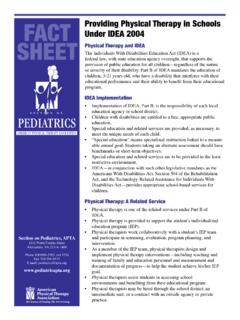

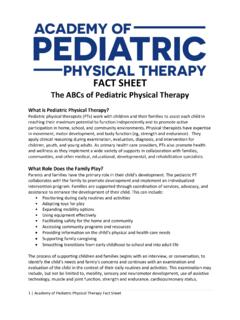
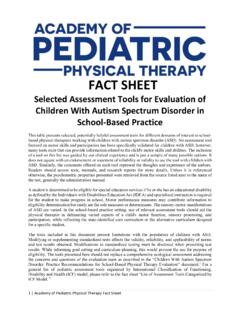
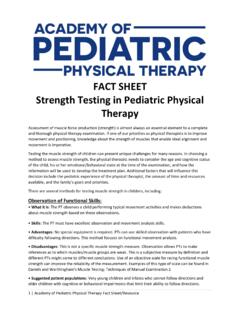
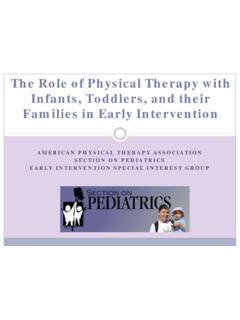


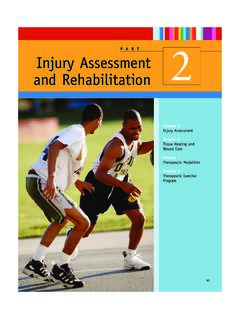

![[ FACILITY ] LIFT PROGRAM POLICY AND GUIDE](/cache/preview/6/4/e/a/0/b/b/0/thumb-64ea0bb0ff01063ef36407a3244742b9.jpg)
